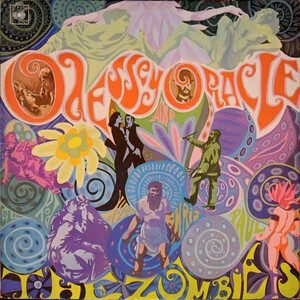Released in April 1968, Odessey and Oracle stands as The Zombies’ magnum opus—a psychedelic pop masterpiece that defied initial obscurity to become one of the most revered albums of its era. Coming at the tail end of the British Invasion, the album marked a significant evolution from the band’s earlier work. While their previous hits like “She’s Not There” and “Tell Her No” showcased their knack for jazz-inflected pop and moody harmonies, Odessey and Oracle ventured into a more sophisticated, baroque-psychedelic sound, aligning them with the likes of The Beatles’ Sgt. Pepper’s Lonely Hearts Club Band and The Beach Boys’ Pet Sounds.
The album was conceived as a carefully crafted studio project—one of the last to be recorded at Abbey Road Studios using its iconic four-track setup before the facility upgraded to eight-track. With a lush, intricate production style, Odessey and Oracle saw The Zombies fully embrace layered vocal harmonies, rich Mellotron textures, and evocative storytelling, all while maintaining an emotional core that resonated beyond the era’s typical psychedelic trappings.
Though the band had already decided to part ways by the time of the album’s release, they poured their creative ambitions into these twelve tracks. Songwriters Rod Argent and Chris White sought to craft something timeless, weaving narratives of love, loss, war, and nostalgia into a seamless, dreamlike experience. While commercial success initially eluded the record, its artistic intentions were clear—this was an album meant to be heard as a whole, a conceptual and sonic journey rather than just a collection of singles.
Sonic Exploration

Production Quality
Recorded at Abbey Road Studios in 1967, Odessey and Oracle is a testament to the ingenuity of The Zombies and their producers, despite the limitations of four-track recording. Unlike the lo-fi, garage-rock aesthetic that defined some of their contemporaries, The Zombies opted for a meticulous, richly layered sound. The production is crisp and detailed, allowing each instrument to shine while maintaining an intimate, almost dreamlike quality.
Key to this sonic clarity was the band’s decision to self-produce the album, giving them full creative control. The result is an immaculately arranged work where every note feels deliberate—whether it’s the warm resonance of the Mellotron, the intricate vocal harmonies, or the delicate piano lines that thread through the album. The production isn’t overly polished or sterile, but it achieves a balance of warmth and precision that elevates the emotional depth of the songs.
Musical Arrangements
What sets Odessey and Oracle apart from other records of its time is its dazzling array of instrumental and vocal arrangements. The Zombies embraced a baroque-pop sensibility, using the Mellotron as a key textural element, much like The Beatles did on Strawberry Fields Forever. Rod Argent’s piano work is particularly striking, lending both rhythmic propulsion and melodic beauty, as heard in the bright, bouncing intro of “Care of Cell 44” or the melancholic elegance of “A Rose for Emily.”
The vocal harmonies—often stacking three or four voices—are some of the most intricate of the era. Tracks like “Maybe After He’s Gone” and “Hung Up on a Dream” showcase this layered choral approach, creating a sense of grandeur within the album’s compact runtime. Even the percussion choices, from the soft tambourine shimmers to the military-style drumming on “Butcher’s Tale (Western Front 1914),” contribute to the immersive storytelling.
Genre Elements
At its core, Odessey and Oracle is a baroque pop album, but it seamlessly incorporates elements of psychedelia, folk, chamber pop, and jazz-inflected rock. The band never fully dives into the acid-soaked, surreal psychedelia of some of their peers, instead opting for a more refined, melodic approach reminiscent of The Beach Boys’ Pet Sounds.
There’s also a timeless quality to its genre-blending—“Friends of Mine” carries the cheerfulness of classic 60s pop, while “This Will Be Our Year” has a soulfulness that wouldn’t feel out of place in the Motown catalog. Meanwhile, the haunting “Butcher’s Tale (Western Front 1914)” stands apart as a stark anti-war ballad, stripped down to Colin Blunstone’s fragile voice over a ghostly harmonium, evoking the loneliness and horror of war in a way that feels chillingly modern.
Lyrical Analysis

Themes and Messages
One of the most striking aspects of Odessey and Oracle is its deeply human and introspective lyricism. Rather than embracing the esoteric, drug-induced surrealism that defined much of late-’60s psychedelia, The Zombies crafted an album rooted in memory, longing, and emotional nuance.
Recurring themes include nostalgia, the passage of time, and bittersweet love. The album opens with “Care of Cell 44,” a deceptively upbeat song about anticipating a lover’s release from prison—a unique twist on the typical love-song narrative. “A Rose for Emily” paints a somber portrait of solitude, loneliness, and the unfulfilled hope of romance, evoking a literary depth reminiscent of its namesake, the William Faulkner short story. Meanwhile, “Maybe After He’s Gone” and “I Want Her She Wants Me” explore heartbreak and the uncertainty of love with poetic restraint.
There’s also a subtle social consciousness embedded in the album. “Butcher’s Tale (Western Front 1914)” is a chilling anti-war statement told from the perspective of a soldier in World War I, his voice cracking with despair over a sparse harmonium. The closing track, “Time of the Season,” shifts the focus to a more sensual, hypnotic meditation on love and attraction, though even here, the delivery feels more ghostly than celebratory.
Lyrical Depth
Unlike many of their psychedelic-era peers, The Zombies favored direct storytelling and poetic elegance over cryptic, hallucinatory imagery. The lyrics often read like short vignettes, rich in detail yet emotionally restrained, allowing the listener to fill in the emotional gaps.
For example, in “Maybe After He’s Gone,” the simplicity of lines like:
“Maybe after he’s gone/ She’ll come back/ Love me again.”
captures heartbreak in a way that feels universal—no elaborate metaphors, just quiet desperation. Similarly, “Friends of Mine” is a joyous yet deeply personal celebration of young love, listing real-life couples the band knew, making the song feel intimate and sincere rather than clichéd.
Even when the lyrics take on more impressionistic qualities, as in “Hung Up on a Dream”, the poetic phrasing remains vivid and evocative:
“A dream unusual of its kind/ That gave me peace and blew my mind/ And now I’m hung up on a dream.”
This line, filled with ambiguity and wistfulness, suggests a fleeting moment of connection and loss—a hallmark of the album’s overall lyrical mood.
Emotional Impact
The emotional pull of Odessey and Oracle is undeniable. Every track, whether soaring with romantic optimism or sinking into sorrow, feels deeply personal yet universally resonant.
The album’s most emotionally devastating moments come in songs like “Butcher’s Tale (Western Front 1914)”, where the stark lyrics and haunting melody place the listener directly in the trenches of war, and “A Rose for Emily,” where the imagery of a woman waiting endlessly for love becomes a metaphor for the passage of time and regret.
Conversely, there are flashes of warmth and hope—“This Will Be Our Year” is one of the most uplifting songs on the record, with lyrics that celebrate resilience and enduring love:
“You don’t have to worry / All your worried days are gone / This will be our year / Took a long time to come.”
Yet, even in its optimism, the song carries a hint of wistfulness, as if it’s clinging to a hope that may not last.
Cohesion and Flow

Track Progression
One of Odessey and Oracle’s greatest strengths is its thoughtful sequencing, which guides the listener through a spectrum of emotions while maintaining a natural flow. The album doesn’t follow a strict narrative, but there’s a distinct sense of movement—from anticipation to nostalgia, heartbreak to hope, despair to transcendence—that makes it feel like a unified journey rather than a collection of disconnected songs.
The record opens on a bright note with “Care of Cell 44”, its major-key exuberance and intricate harmonies setting a deceptively upbeat tone. The song’s theme of waiting for a loved one’s return subtly introduces the album’s recurring motifs of longing and the passage of time. This is immediately followed by “A Rose for Emily,” a stark contrast in both instrumentation and mood—a move that signals the album’s willingness to shift between emotions while maintaining an overarching cohesion.
The middle section of the album is its most immersive, diving into lush, dreamlike soundscapes. Tracks like “Beechwood Park” and “Hung Up on a Dream” evoke hazy nostalgia, their melodies floating like distant memories. This stretch of the album feels particularly fluid, each song bleeding naturally into the next while deepening the themes of reminiscence and yearning.
Then, near the end, the album takes an unexpected turn with “Butcher’s Tale (Western Front 1914).” The stark, war-torn imagery and minimal arrangement make it a jarring yet purposeful shift—a moment of historical and existential weight that temporarily interrupts the album’s intimate focus on personal relationships. However, this detour only enhances the impact of the final two songs: “Friends of Mine,” which bursts with communal joy, and “Time of the Season,” which closes the album with a hypnotic, almost mystical farewell.
Thematic Consistency
Despite its variety of moods and subject matter, Odessey and Oracle maintains a remarkable thematic and musical cohesion. At its core, the album is an exploration of time—how we experience it, how it changes us, and how we cling to its fleeting moments. Whether it’s the wistful reminiscence of “Beechwood Park”, the aching loneliness of “Maybe After He’s Gone”, or the forward-looking optimism of “This Will Be Our Year”, each song is in conversation with the others, reinforcing the album’s emotional depth.
Musically, the album also achieves a seamless blend of baroque pop, psychedelic rock, and chamber pop. Though it flirts with different moods and styles—switching from orchestral ballads to jazz-inflected grooves to stripped-down laments—the intricate vocal harmonies, warm production, and consistent melodic sensibility tie everything together. Even “Butcher’s Tale,” with its stark departure in tone, ultimately fits within the album’s broader meditation on fragility, time, and human experience.
Standout Tracks and Moments
Highlight Key Tracks
While Odessey and Oracle is a remarkably consistent album, certain tracks stand out for their artistic brilliance, innovation, and emotional weight.
“Care of Cell 44”
The album’s joyous yet unconventional opener immediately sets Odessey and Oracle apart from its contemporaries. The subject matter—a narrator excitedly awaiting the release of a loved one from prison—is unusual for a pop song, yet its buoyant harmonies, cascading piano lines, and shifting chord progressions make it an instant classic. The contrast between the song’s cheerful sound and its unexpectedly somber lyrics adds to its lasting intrigue.
“A Rose for Emily”
Stripped down to just Colin Blunstone’s delicate vocals and Rod Argent’s melancholic piano, this song embodies the album’s themes of loneliness and regret. The starkness of the arrangement—no drums, no harmonies, just a quiet, haunting melody—makes it one of the most intimate and emotionally resonant moments on the album.
“Beechwood Park”
Few songs capture nostalgia as effortlessly as this one. The hazy, reverb-soaked atmosphere evokes the feeling of a warm summer day fading into memory, while the lyrics transport the listener to a place suspended between past and present. Chris White’s bass work shines here, subtly grounding the dreamlike quality of the track.
“Butcher’s Tale (Western Front 1914)”
The album’s most harrowing moment, this wartime ballad is a stark departure from the rest of Odessey and Oracle, yet its raw vulnerability and chilling delivery make it unforgettable. Sung by bassist Chris White in a fragile, almost ghostly tone, the track features only a haunted harmonium as accompaniment, reinforcing its bleak and desolate mood. The lyrics, told from the perspective of a soldier facing death, offer a rare and deeply moving anti-war statement within a pop album.
“Time of the Season”
The album’s best-known track and one of the most hypnotic songs of the 1960s. Its jazzy electric piano riff, whispered call-and-response vocals, and sultry groove make it stand apart from the rest of the album’s more orchestral-leaning compositions. Rod Argent’s soulful organ solo is a highlight, cementing the song’s status as a psychedelic masterpiece.
Memorable Moments
- The Opening Bars of “Care of Cell 44” – The cascading piano introduction, paired with the warm, stacked harmonies, creates an instant sense of joy and forward momentum—one of the most inviting openings to any album of the era.
- The Last Line of “A Rose for Emily” – “And as the years go by, she will grow old and die”—a heartbreaking and final statement that lingers in silence, making the weight of the song’s loneliness even more profound.
- The Dreamlike Transition in “Hung Up on a Dream” – When the instrumentation swells midway through the track, it feels like stepping into another dimension—a perfectly executed psychedelic crescendo that captures the album’s ethereal magic.
- The Whispered “Who’s Your Daddy?” in “Time of the Season” – A seemingly playful yet haunting moment, where Blunstone’s breathy vocal delivery turns a simple phrase into something strangely hypnotic and unforgettable.
Artistic Contribution and Innovation

Place in Genre/Industry
Upon its release in 1968, Odessey and Oracle struggled to make an immediate impact, largely due to poor promotion and the band’s premature breakup. However, over time, it has been rightfully recognized as one of the defining albums of the psychedelic and baroque pop movements, often ranked alongside Pet Sounds and Sgt. Pepper’s Lonely Hearts Club Band in discussions of the era’s most artful and ambitious records.
While many bands in the late ’60s were diving into heavy, effects-laden psychedelia, The Zombies took a more refined, melodic approach. Instead of fuzzed-out guitar jams and sprawling improvisations, they crafted an album where every note was meticulously arranged, drawing from classical, jazz, and folk influences to create something more intimate and sophisticated.
Though Odessey and Oracle never achieved the mainstream commercial success of albums by The Beatles or The Beach Boys, it became an essential touchstone for future generations. Artists as diverse as Paul Weller, Elliott Smith, The Flaming Lips, and Fleet Foxes have cited it as a major influence, and its meticulous production style and lush, layered harmonies continue to inspire modern indie and chamber pop artists.
Innovation
While Odessey and Oracle fits comfortably within the psychedelic and baroque pop movements, it does so without relying on the genre’s typical excesses. The album sidesteps the overindulgent, effects-heavy approach that defined much of late-’60s psych-rock, instead focusing on tight songcraft, intricate harmonies, and carefully orchestrated arrangements.
Some of its most innovative qualities include:
- The Use of the Mellotron – While the Mellotron had been famously used by The Beatles on Strawberry Fields Forever, The Zombies employed it throughout Odessey and Oracle, giving songs like “Hung Up on a Dream” and “Changes” their distinctive, otherworldly atmosphere. Rather than being a gimmick, it became an integral part of the album’s identity, blending with Argent’s piano-driven compositions to create a dreamy, timeless quality.
- Lyrical Storytelling That Defied Psychedelic Tropes – Unlike many albums of the era that leaned into abstract, drug-fueled wordplay, Odessey and Oracle was rooted in personal, literary, and historical themes. The storytelling in “Care of Cell 44”, “A Rose for Emily”, and “Butcher’s Tale (Western Front 1914)” was cinematic and deeply human, offering narratives that felt more akin to classic literature than psychedelic daydreams.
- Sophisticated Harmonic Arrangements – While many psychedelic bands experimented with vocal layering, few achieved the level of intricate harmony work that The Zombies did. Songs like “Friends of Mine” and “This Will Be Our Year” feature vocal stacks reminiscent of The Beach Boys, yet with a distinct British pop sensibility.
- An Unusual Approach to Instrumentation – The absence of flashy guitar solos and the emphasis on piano, Mellotron, and vocal interplay gave the album a sound that was ahead of its time. Instead of trying to compete with the heavier, blues-driven rock emerging in 1968, The Zombies opted for elegance and restraint, which ultimately helped the album age more gracefully than some of its contemporaries.
Closing Thoughts

Odessey and Oracle is a remarkable achievement, blending thoughtful lyricism, innovative production, and sophisticated arrangements into a cohesive and emotionally rich experience. Its strengths lie in its meticulous craftsmanship—every song feels deliberate, every harmony perfectly placed, and every lyric carefully considered. The album’s exploration of themes like nostalgia, love, and the passage of time resonates deeply, providing a timeless quality that keeps listeners returning decades after its release.
Where some might see a weakness in its lack of immediate commercial success, it’s this very underdog status that has allowed the album to grow into a cult classic, appreciated by those who seek it out. Its subtlety and refinement may not have captured the zeitgeist as forcefully as contemporaries like Sgt. Pepper or Pet Sounds, but this works in its favor, giving the album an enduring freshness and relevance. It’s an album that rewards careful listening, revealing more of its intricate beauty with each spin.
For The Zombies, Odessey and Oracle was a bittersweet swan song, released after the band had already decided to part ways. But what a legacy to leave behind! It encapsulates their artistic peak, a testament to what a band can achieve when they pour every ounce of creativity into their work. It’s a high point not just in their career but in the broader tapestry of 1960s music—a quiet revolution in sound and sentiment.
Official Rating
We awatd Odessey and Oracle a perfect 10/10 score. Why a perfect score? Because Odessey and Oracle is flawless in its ambition and execution. It’s a rare album that manages to be both timeless and of its time, capturing the spirit of the late ’60s while transcending it. Its emotional depth, innovative production, and lyrical sophistication create a listening experience that’s both intellectually satisfying and deeply moving. It’s an album that stands not only as The Zombies’ crowning achievement but as a pinnacle of popular music, reminding us that the most beautiful art often blooms quietly, waiting patiently to be discovered.
